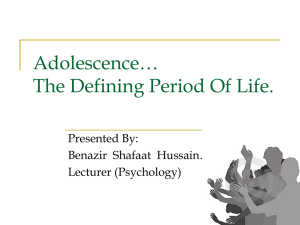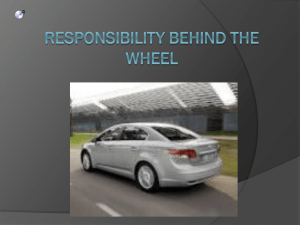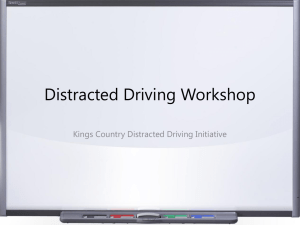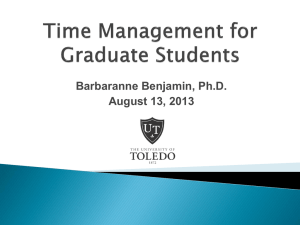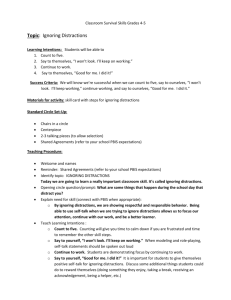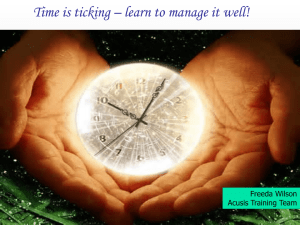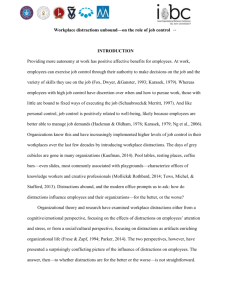FOCUS System
advertisement
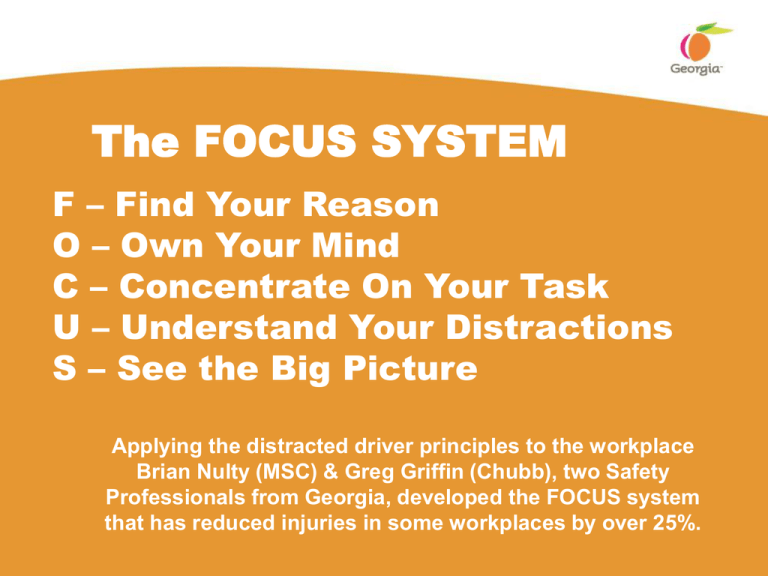
The FOCUS SYSTEM F – Find Your Reason O – Own Your Mind C – Concentrate On Your Task U – Understand Your Distractions S – See the Big Picture Applying the distracted driver principles to the workplace Brian Nulty (MSC) & Greg Griffin (Chubb), two Safety Professionals from Georgia, developed the FOCUS system that has reduced injuries in some workplaces by over 25%. WHY THE FOCUS SYSTEM?? • Distracted associates like Distracted Drivers are at a greater risk of being involved in an incident and injury • 85 to 90% of Injuries at some companies • Distraction Rate - % of incidents where distractions were the proximate cause • Incidents and injuries are caused when associates are distracted while performing their work • We want To BE AND STAY proactive in the areas of safety, quality, & productivity 2 FOCUS Triangle 1 Severe Injury or Damage 30 Incidents ZEN Proverb 300 Distractions Near Misses “When walking, walk. When eating, eat.” •Do one thing at a time. – The basic step is to keep it simple: singletask, avoid multi-tasking. 3 Are These Distractions? • • • • • • Birth/Death in Family Divorce/Separation/Marriage Crowded Work Area Financial/Mortgage Health/Diet Coworker/Supervisor One Method to Deal with Distractions: Take Mini-breaks to let your mind wander (10 – 15 seconds) – write it down then return to work/task. 4 Distractions can lead to injury • The more distractions we have; the greater chance of being injured. • The chance of being injured, when distracted, is 40% to 80% higher. • FOCUS will not solve the distractions but will help make you AWARE of injury causing distractions. Inattention is involved in 78% of all observed crashes and 66% of all crash events (crash/near crash). 5 FIND YOUR REASON • Personalize it. ▪ Why is safety important to YOU. • Self Preservation. ▪ Who wants to be injured. • Your Family Needs You. WHAT IS YOUR REASON FOR STAYING FOCUSED? 6 OWN YOUR MIND • Own & Control Your Frustrations. ▪ Stop and ask for help. • Own & Choose Your Attitude. ▪ Stay Positive. • Avoid Overconfidence. ▪ Don’t get too comfortable. • Keep Your Mind On Your Work. • WHAT IS YOUR ATTITUDE TODAY? 7 CONCENTRATE ON YOUR TASK • Keep Your Eyes On Your Work ▪ Focus on the task at hand ▪ Looking ahead while walking and driving • Follow The Job’s Procedures ▪ Written with Safety in mind • Critical Tasks Include: ▪ Material Handling Equipment ▪ Lifting Items ▪ Placement Of Items • Understand Hand and Feet Placement ▪ How to carry, lift, move, slide, and handle an item ▪ Maintain a 3 point contact on stairs and ladders • WHAT IS THE PROCEDURE TO KEEP YOUR EYES ON? 8 UNDERSTAND YOUR DISTRACTIONS • Know Your Cognitive Distractions ▪ Thinking, reasoning, remembering, imagining. • Know Your Physical Distractions ▪ Radios and surrounding environment. • Associate Conversations ▪ When we talk and try to perform critical tasks our minds may not be on the task. • Personal Matters ▪ Things in your everyday life. • WHAT THINGS CAUSE YOU TO BE DISTRACTED? 9 SEE THE BIG PICTURE • Know Your Fatigue/Energy Level ▪ When tired – FOCUS ▪ Exercise and Diet • Don’t Rush ▪ Know the times that cause you to rush - FOCUS • Avoid Shortcuts ▪ Follow procedures • Take Your Time With Unfamiliar Items & Tasks • WHAT IS TIME NEEDED TO DO IT SAFELY? 10

